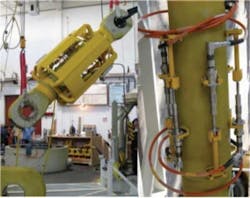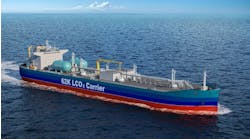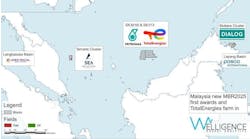Doris Engineering is performing pre-FEED studies for an LNG FPSO offshore northern Australia. Operator GDF Suez is considering this solution for its Petrel/Tern/Frigate gas fields development in the Bonaparte Basin, 300 km (186 mi) west of Darwin.
Doris’s study is for the “midstream” part of the development (the FPSO), while Granherne was awarded pre-FEED of the upstream part, including subsea facilities and the wellhead platform.
Location of the proposed LNG offshore development in the Bonaparte basin.
According to Doris’ CEO Loïc des Déserts, GDF Suez had screened alternative concepts since establishing its joint venture with Santos in August 2009, but FLNG is now the main contender.
The three fields were discovered by ARCO in the 1960s and 1970s, but the relatively low combined reserves – several tcf – have discouraged development until now. However, advances in floating offshore liquefaction should make the Bonaparte basin project technically feasible. “The resultant FLNG scheme will be one of the smallest around,” says des Déserts, “and that makes it easier to design.”
Project economics could also be improved by keeping all processing offshore, rather than putting in a pipeline to Darwin and an onshore liquefaction plant. In any case, Darwin already has these facilities for ConocoPhillips’ Bayu-Undan development. Another advantage of FLNG is that it limits disruption from militant Australian union labor during the construction (capex) phase – this is because the FLNG fabrication would be performed outside Australia, as opposed to an onshore LNG facility that would be erected locally and therefore under the scrutiny of the unions.
Doris has allocated around 15 staff for the pre-FEED at its offices in Paris, working in close collaboration with GDF Suez. They are examining options for plateau production based on two gas inlet flow rates: the base case is 360 MMcf/d or 2 MTPA, with a high case of 540 MMcf/d, or 3 MPTA. The base case liquefaction process is the nitrogen double expansion loop process.
The team is studying requirements for four different layout configurations. In one case, for instance, all process equipment and storage is onboard the FPSO, while in another, condensate storage is switched to the upstream platform. Additionally, the team is reviewing options for an FPSO that include facilities dedicated to Bonaparte, or an FPSO with additional facilities (i.e. deck space, storage) for use in a future re-deployment.
“The offshore environment in this region is severe,” des Déserts points out, “with potential for very high sloshing, and this requires a lot of work on the containment system. The safety aspect will have a big impact on the layout of the topsides,” he adds, and therefore on the size of the hull, which will be of a conventional shape. The vessel would be moored in about 100 m [328 ft] of water.”
Following completion of the pre-FEED study, assuming the joint venture partners persevere with the concept, they will probably launch a design competition for the EPC program. If this happens, Doris will look to bid in partnership with another contractor. Doris also hopes to participate in Inpex’s much larger Ichthys LNG project in the same region, which would require facilities onshore to liquefy gas from offshore fields in the range 15 MPTA.
Angola expansion
Elsewhere, Doris has established a subsidiary in Luanda, Doris Engenharia Angola Ltda (DEAL), to satisfy the government’s demands for increased local content in oil and gasfield projects. “We are employing a mix of Angolan engineers and ex-pats there, but also bringing Angolan ex-pats to Paris or Houston for training. We give them projects – their role could be related to any aspect of engineering – so that they get to know how we work and can apply that in Luanda,” des Déserts notes.
“This subsidiary will perform any type of engineering, including conceptual FEED and detail engineering. Our ultimate goal, in a few years time, is to have all engineering for Angolan projects done locally.”
Currently, DEAL is performing studies for the national gas company Sonagas and is bidding for the FEED for Chevron’s Lucapa project in block 14 (partly subcontracted to Doris Inc. in Houston). DEAL will also bid for Total’s Kaombo project in ultra-deepwater block 32, which calls for two FPSOs.
Recently, Doris submitted a second bid for operation of all BP’s subsea equipment offshore Angola, having been invited to re-tender. This relates to existing and emerging facilities in blocks 18 and 31. The program involves providing engineering assistance for maintenance of subsea equipment and scheduling activities. If this bid is successful, the work would again be undertaken by DEAL.
Doris has performed various new studies within the Angola ADC consortium for the major operators BP, Chevron, ENI, ExxonMobil, Petrobras, and Total. One involved conceptual work on long-distance subsea tiebacks. Another ADC study examined options for a subsea pipeline repair system, with a shared vessel and equipment spread. And a further study is under way on SIMOPs to manage disruption to offshore operations, drawing on feedback from projects provided by the participating companies.
“Today,” des Déserts adds, “we are developing a database in Angola on the reliability of subsea equipment – all the operators are providing the available data on their subsea kit to that database, and they can each recover this information and treat it as they wish.”
In block 17, Doris undertook the FEED for the GiRi project, which involves tying further accumulations back to the Girassol FPSO to maintain plateau production. Doris investigated options for single-phase production and subsea multiphase pumping. The EPC tenders for this project have been launched. And in Houston, Doris Inc is working for Maersk on the planned FPSO for the deepwater Chissonga field.
Offshore Articles Archives
View Oil and Gas Articles on PennEnergy.com




